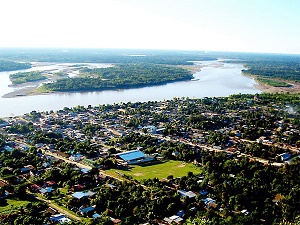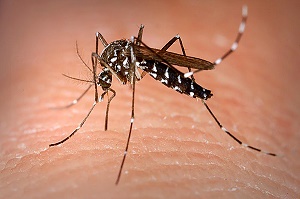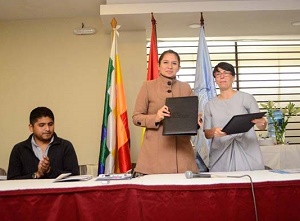Also available in: Español
Source: Corresponsales Clave
“Malaria Free Bolivia to Live Well” is the project currently under implementation in the country and it aims to eliminate malaria from the country. The following report outlines the situation of malaria in the Andean country, as well as the actions taken to eradicate it.
By: Marlene Caero Herbas
The surface of the Amazon region Bolivia corresponds to 75% of the national territory and 11.20% of the entire continental Amazon basin. It covers the provinces of Beni, Pando, Santa Cruz, part of La Paz and Cochabamba. It is inhabited by different indigenous peoples who, despite the passing of time, preserve some of their beliefs and culture intact.
Boliviana Amazon region. Photo: Pampas Bolivia.
 It is in this Amazon region, where the hand of man has not reached completely, where one can still breathe fresh air and watch birds fly freely, it is in this territory worth of the best postcards pictures where its inhabitants coexist with malaria.
It is in this Amazon region, where the hand of man has not reached completely, where one can still breathe fresh air and watch birds fly freely, it is in this territory worth of the best postcards pictures where its inhabitants coexist with malaria.
What is malaria?
Percy Calderón, Health Advisor at UNDP-Global Fund, explained Corresponsales Clave that malaria is a disease caused by a parasite of the genus Plasmodium and transmitted through the bite of a mosquito of the genus Anopheles. There are 4 types worldwide: P. vivax, P. falciparum, P. malariae, and P. ovale. In Bolivia, there are only two: P. vivax and P. falciparum.
He also mentioned that this disease is considered a public health problem because it is focused on tropical locations and is one of the main causes of morbidity and mortality in these areas.
Malaria in Bolivia
Karen Peña, Communicator at UNDP Global Fund Project, points out that malaria is located primarily in the Amazon region of the country, where 95% of the cases come from, specifically from the Beni, Pando and north of La Paz provinces. A hyperendemic situation (50 cases in 1000 inhabitants) has been defined in Santos Mercado, Nueva Esperanza (Pando) and Guayaramerín (Beni), the only city with reported malaria cases, as most cases are found in rural areas. With regards to the Extra-Amazon region, malaria cases may be found in Chuquisaca, Tarija and Potosí.
 Bolivian Amazon region. Photo: Andes Discovery.
Bolivian Amazon region. Photo: Andes Discovery.
Peña comments that the Bolivia Libre de Malaria (Malaria-Free Bolivia) Project began its activities in October 2009 and concluded in September 2014 with an investment of 14 million dollars. Subsequently, an extension period was granted in order to provide continuity to the basic services.
“During this first stage, the project aimed at accelerating the process of reducing malaria in the most endemic area of the country, giving priority to elimination of malaria through P. falciparum at national level. To achieve this goal, the strategy used consisted in improving the promotion, prevention and management services for malaria cases, and the consequent extension of coverage. (…) Rapid diagnostic tests were put in place, handled by volunteers who also took charge of dispensing specific treatments with antimalarial drugs in compliance with national standards. Out of 160 volunteers, 45% belonged to indigenous and native communities”, Peña comments.
“One of the most important strategies that have had quite an impact on the incidence of this disease is the strengthening of community surveillance by means of training a network of malaria social collaborators distributed throughout the Bolivian Amazon region, who were trained in the use of rapid diagnostic tests and drug dispensing, in such way that the rapid diagnostic strategy and the timely treatment in less than 24 hours has achieved the expected impact”, adds Calderón.
Karen Peña points out that this work was acknowledged by the Global Fund through their qualifications: “The work conducted by the Principal Recipients of each component with regards to the relevant project is qualified every six months (programmatic periods). The United Nations Development Programme Bolivia (principal recipient in Bolivia) has maintained the A1 qualification since 2013 due to the implementation of the Malaria-Free Bolivia Project (led by the Ministry of Health), year in which the project achieved stability and expectations exceeded the proposal.”
Transmitting mosquito.
Another important step for the country was meeting the MDG’s 6C goal, which states: To have halted by 2015 and begun to reverse the incidence of malaria and other major diseases.
 By 2015, Bolivia had achieved this goal, going from 14,000 cases to 7,000 malaria cases. It also managed to reduce malaria cases caused by P. falciparum from 2500 cases in 2010 to less than 100 on 2015. Until June that year, less than 10 autochthonous cases by P. falciprum were reported. Progress has been remarkable. Al 2015 Bolivia ha logrado cumplir con ese objetivo. Pasó de 14 000 casos de malaria a 7 000 casos. Así mismo se ha logrado reducir los casos de malaria por P. falciparum de 2 500 el 2010 a menos de 100 para el 2015. Hasta junio de ese año se ha reportado menos de 10 casos autóctonos de P. falciprum. El avance ha sido notable.
By 2015, Bolivia had achieved this goal, going from 14,000 cases to 7,000 malaria cases. It also managed to reduce malaria cases caused by P. falciparum from 2500 cases in 2010 to less than 100 on 2015. Until June that year, less than 10 autochthonous cases by P. falciprum were reported. Progress has been remarkable. Al 2015 Bolivia ha logrado cumplir con ese objetivo. Pasó de 14 000 casos de malaria a 7 000 casos. Así mismo se ha logrado reducir los casos de malaria por P. falciparum de 2 500 el 2010 a menos de 100 para el 2015. Hasta junio de ese año se ha reportado menos de 10 casos autóctonos de P. falciprum. El avance ha sido notable.
Bolivia Malaria Free to Live Well
In March 2016, a new project took off called Malaria Free Bolivia to Live Well, which aims to eradicate malaria from the Bolivian Amazon region by intervening in 19 municipalities throughout the country. UNDP was reelected as main receiver and the Global Fund is investing an amount of US $10,333,317, a funding to be implemented until 2018.
Karen Peña explains that the activities set forth in the concept note or country proposal are framed to meet the objective of “Reducing the occurrence of malaria cases by 50% in Bolivia and eliminate the occurrence of autochthonous malaria cases by P. falciparum at the national level”. The goals considered in the proposal are: 1) To eliminate autochthonous transmission through Plasmodium falciparum in Bolivia by 2019; 2) Reduce by 50% the number of P. vivax cases in the 16 endemic municipalities of Pando, Beni, La Paz provinces by 2019; 3) Interrupt the P. vivax autochthonous transmission in the 15 low-endemic priority municipalities by the year 2019 and prevent the reintroduction of malaria in 5 transmission-free municipalities in Chuquisaca, Santa Cruz, Tarija and Potosí provinces.
 Little girl getting medication. Photo: PNUD.
Little girl getting medication. Photo: PNUD.
To achieve this, two key axes were proposed: Malaria Case Management, ensuring immediate and quality universal access to diagnosis, treatment and monitoring of malaria, and Vector Control, which promotes, strengthens and optimizes the mechanisms and tools for vector control.
To this end, an agreement has also been signed with the Ministry of Health, aiming to providing continuity and consolidation to the control and eradication of the malaria strategy in the Amazon area, which concentrates 95% of the cases reported nationally.
Reaching the most remote places in the Bolivian Amazon region with information and health access to cope with malaria is not easy, but it is being possible thanks to the effort and the work conducted jointly among the Ministry of Health, UNDP, the financial support from the Global Fund and the combined effort of all the communities and people involved who cooperate and look forward to achieving the eradication of malaria in the country.
Further interesting details
Transmission and Symptoms
Female Anopheles mosquitoes lay their eggs in the water. After they hatch, the larvae develop to become adult mosquitoes. Female mosquitoes seek their food in blood to nourish their eggs. (WHO)
Transmission takes place through the bite of the female Anopheles mosquito; transmission may also occur through the transfusion of blood infected with parasites, although nowadays this pathway is less likely due to quality controls in blood banks.
The symptoms after the mosquito bite are fever, chills, sweating, headache, and nausea.
Malaria in the world
 Signing of the Agreement between the Ministry of Health and UNDP. Photo: Ministry of Health.
Signing of the Agreement between the Ministry of Health and UNDP. Photo: Ministry of Health.
One third of the world population lives in areas at risk of malaria transmission. It is estimated that there are between 300 and 500 million cases per year worldwide.
According to the World Health Organization (WHO) World Malaria Report 2015, more than half of the 106 countries affected by this disease in 2000 have succeeded in reducing the number of new cases in at least 75% by 2015. In the same period, 18 other countries have achieved reductions of between 50% and 75%.
WHO also notes that, since 2000, malaria mortality rates have decreased by 72% in the Americas Region, 65% in the Western Pacific Region and 64% in the Eastern Mediterranean Region. Africa continues to bear the highest malaria burden, but progress has been reported: Mortality rates have declined by 66% among all age groups, and by 71% among children under five. And for the first time since WHO began keeping a record, the European Region has reported zero autochthonous cases of malaria.
All articles may be shared and published provided the source data is cited.
